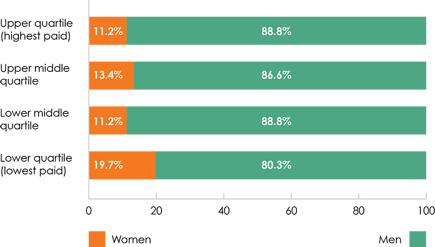Laing O'Rourke 2022 Gender Pay Gap Report
31.03.23The 2022 Laing O’Rourke Gender Pay Gap report was submitted to the UK Government today, showing a continuing increase in the number of women employed in senior levels.
When the company’s first report was published in 2017, it was acknowledged that the gender pay gap was largely driven by a lack of female representation in senior management positions and a commitment was made to do more to attract, develop and retain women within the organisation.
This commitment was strengthened when Laing O’Rourke announced its sustainability targets, putting on record that by 2033, they want to have an equal number of men and women across their global staff population.
Gender balanced Board membership
Today, half of their Board members are women and, as reported in last month’s FTSE Women Leaders Review, 43% of the UK leadership roles (defined by the FTSE as executive committee and direct reports or equivalent) are occupied by women.

The achievement saw Laing O’Rourke top the ranks of the construction sector and put it sixth out of all the UK’s private firms for women in leadership.
While encouraged by the growth in senior leadership, and the subsequent impact it has on narrowing the gender pay gap, the company knows it has a way to go. Its resolve to address barriers to employment, for all under-represented groups within the industry remains undented and they are determined to create a workplace where everyone feels a sense of belonging, and an environment where all its people can thrive.
Pay gap figures
Under the calculations required by Government, in April 2022 women’s median* hourly pay was 3.9% lower than men’s (vs 2021: 4.0%) and mean* hourly pay was 5.0% lower than men (vs 2021: 8.1%).
 The number of women across all quartiles continues to grow, albeit the figures show that the organisation, and the sector as a whole remains male dominated.
The number of women across all quartiles continues to grow, albeit the figures show that the organisation, and the sector as a whole remains male dominated.
You can read the Gender Pay Gap report on the Laing O’Rourke website.
Although pleased to see that the pay gap has narrowed, Laing O’Rourke remain vigilant to the restrictions of the reporting requirements. As outlined previously by Rae Avatar Barnett, Head of the People function – Europe:
“While the data required by Government provides a useful snapshot of a moment in time, at Laing O’Rourke we are driven by our longer-term goal to achieve 50:50 gender representation in staff roles, and to improve the quality of employment of all colleagues across construction, which will open up careers to women and other under-represented groups in this sector.
“Movement each year in overall gender pay gaps can be driven more by changes in demographics that are out of our control, than by changes to pay policies.
“While the UK gender pay reporting guidelines don’t recognise the impact of the different operating models in the construction sector, such as our unique direct delivery approach, the requirements have been a catalyst for deep data analysis which has helped inform our action planning and broader sustainability targets.”
Tipping the balance
The strive for greater gender balance has seen Laing O’Rourke examine its recruitment efforts, the policies and frameworks that support diversity and its working culture. Stepping stones have been put in place that will, in time, accelerate and support a journey towards 50/50, making it an attractive employer. The organisation says it will continue to listen to its people and take inspiration from other organisations across the globe as it pushes the boundaries and creates an exciting and caring workplace. Some recent successes are shown below.
Supportive processes, policies and benefits
- The launch of an industry-leading global parenthood leave policy – a benefit that gives all employees access to 12 months’ parental leave, with six months on full pay, regardless of gender or how they become a parent.
- Anyone returning from six months parenthood leave is entitled to a “phased return”, allowing them to work 80% of their hours for 100% of pay, for three months. This will result in better outcomes for returners, and encourage a culture which embraces part time working.
- Private medical insurance that includes payments towards fertility treatment and gender identity support, plus menopause support available to all employees (even if they do not have PMI).
- Introduction of new professional workwear that is designed and tailored for both women and men.
Stepping stones to success
- Concentrated effort to attract more women to its early talent programmes, with the 2022 intake welcoming:
- 55% intake of women recruited into its Graduate programme
- 46% recruited to the Professional Apprenticeships
- 47% intake to Summer & Industrial Placements; and
- 54% intake of women to the Trade Apprenticeship programme – a jump from 9% in 2021, and one made possible through partnership working with Women in Construction.
- Outside of early talent programmes, new approaches to recruitment meant that Laing O’Rourke increased female appointments by 44% year on year.
- The company recognise that it needs to recruit and develop more women into senior project roles. Mentoring networks and programmes have been introduced with others in the pipeline and since April 2022 a 12% increase in the proportion of women in senior project roles (defined as project-based women within grades 5-7) has been seen.
Understanding the difference between equal pay and the gender pay gap
It’s important to understand the difference between equal pay and the gender pay gap. The gender pay gap is about showing the overall difference in earnings across the entire male and female populations at a company, across all job roles.
Equal pay is about making sure that everyone undertaking like work, of equal value, or rated as equivalent, is paid the same.
To comply with Government gender pay gap reporting, the hourly rate of all employees, (from our directly employed site operatives to Board members) is measured. The average (or “mean”) pay, as well as the median is then calculated. See below for the difference between these definitions.

Laing O’Rourke is confident that its recruitment procedures, pay governance and review processes ensure compliance with equal pay legislation.
*About mean and median in UK Gender Pay Gap reporting

The mean gender pay gap is the difference between all women’s average hourly pay and all men’s average hourly pay.

The median hourly rate is calculated by ranking all employees from the highest paid to the lowest paid and taking the hourly pay of the person in the middle. The median gender pay gap is the difference between women’s median hourly pay (the middle paid woman) and men’s median hourly pay (the middle paid man).

